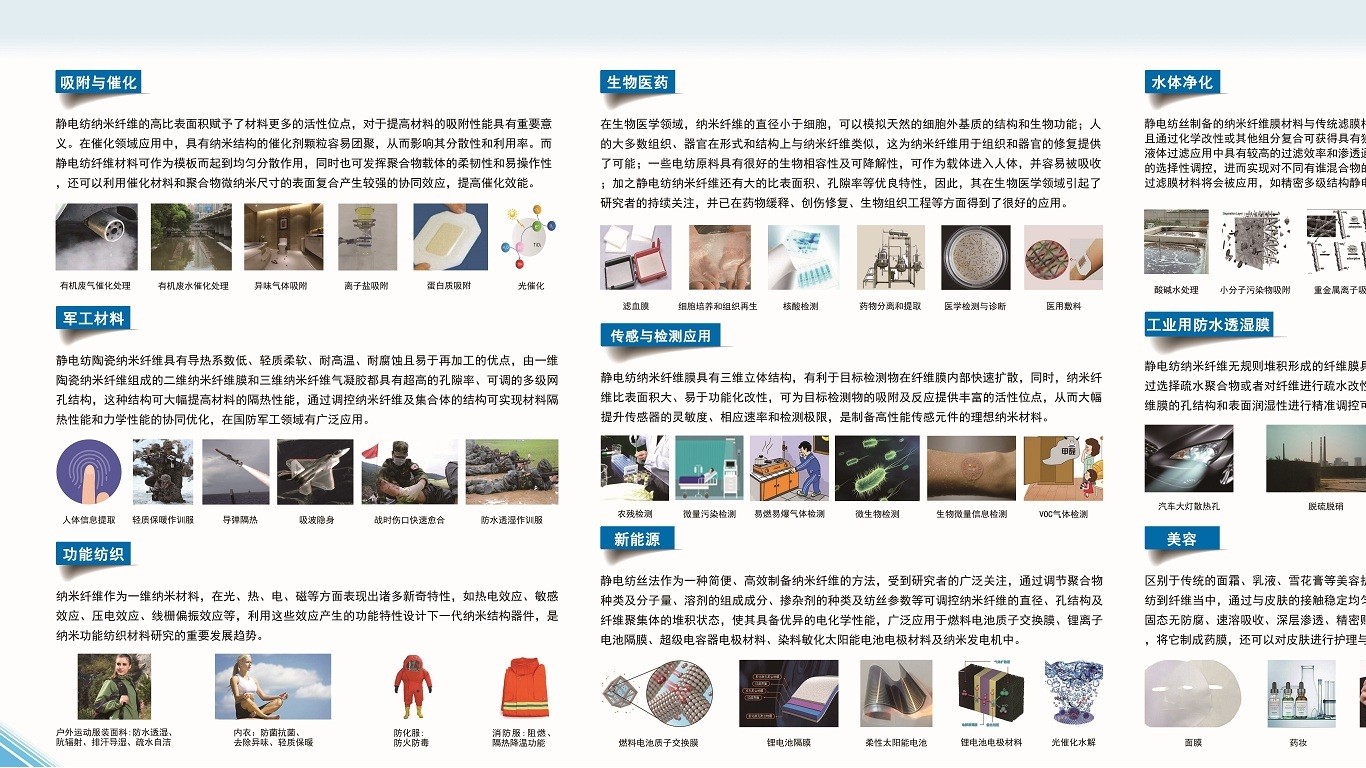
1. Adsorption and Catalysis
The high specific surface area of electrospinning nanofibers endows the material with more active sites, which is of great significance for improving the adsorption property of the material. In the field of catalysis, catalyst particles with nano-structure are easy to aggregate, thus affecting their dispersion and utilization. The electrospinning fiber material can be used as a template to play the role of uniform dispersion, but also can give play to the flexibility and maneuverability of the polymer carrier, can also use the catalytic material and polymer micro-nano-size surface composite to produce a strong synergistic effect, improve the catalytic efficiency.
Catalytic Treatment of Organic Waste Gas
Catalytic Treatment of Organic Wastewater
Odor Gas Adsorption
Ionic Salt Adsorption
Protein Adsorption
2. Military Material
Electrospinning ceramic nanofibers have the advantages of low thermal conductivity, light weight, soft, high temperature resistance, corrosion resistance and easy reprocessing. The two-dimensional nanofiber membrane and three-dimensional nanofiber aerogel composed of one-dimensional ceramic nanofibers have ultra-high porosity and adjustable multistage mesh structure, which can greatly improve the thermal insulation performance of materials. The coordinated optimization of thermal insulation and mechanical properties of materials can be realized by adjusting the structure of nanofibers and aggregates.
Human Body Information Extraction
Lightweight Warm Clothing For Training
Missile Insulation
Absorbing Stealth
Wartime Wounds Heal Quickly
Waterproof And Moisture Permeable Training Clothing
3. Functional Textile
As one-dimensional nanomaterials, nanofibers exhibit many novel properties in light, heat, electricity and magnetism, such as thermoelectric effect, sensitivity effect, piezoelectric effect and linear polarization effect. It is an important trend to design the next generation of nanostructured devices based on the functional properties of these effects.
Outdoor sports clothing fabric: waterproof and moisture-proof, anti-radiation, sweat excrete moisture, hydrophobic and self-cleaning
Underwear: anti-bacterial, anti-odor, lightweight and warm
Fire-fighting Anti-chemical Clothers: protect the body from fire, dangerous chemicals or corrosive substances
Fire clothing: fire retardant, heat insulation cooling function
4. Biological Medicine
In biomedicine, nanofibers are smaller in diameter than cells and can mimic the structure and biological functions of natural extracellular matrices. Most human tissues and organs are similar in form and structure to nanofibers. The nanofibers could be used to repair tissues and organs. Some electrospinning materials have good biocompatibility and degradability, which can be used as carriers to enter the human body and be easily absorbed. In addition, electrospun nanofibers have excellent characteristics such as large specific surface area and porosity. Therefore, they have attracted continuous attention from researchers in the biomedical field, and have been well applied in drug sustained release, wound repair and biological tissue engineering.
Blood filtration membrane
Cell culture and tissue regeneration
Nucleic acid detection
Drug separation and extraction
Medical testing and diagnosis
Medical dressings
5. Sensing and detection applications
Electrospinning nanofiber membrane has a three-dimensional structure, which is conducive to the rapid diffusion of the target detector in the fiber membrane. At the same time, the nanofibers have a large specific surface area, which is easy to be functionalized and modified, and can provide rich active sites for the adsorption and reaction of the target detector, thus greatly improving the sensitivity, corresponding rate and detection limit of the sensor. It is an ideal nano-material for the preparation of high-performance sensor elements.
Detection of pesticide residues
Trace contamination detection
Detection of inflammable and explosive gases
Microbiological detection
Biological microinformation detection
VOC gas detection
6. New Energy
As a simple and efficient method to prepare nanofibers, electrospinning has attracted much attention from researchers. By adjusting the types and molecular weight of polymer, composition of solvent, the type of dopant and spinning parameters such as the diameter of the nanofibers, pore structure and regulation of the accumulation of fiber aggregation state, make its have excellent electrochemical performance, widely used in proton exchange membrane fuel cells, lithium-ion battery diaphragm, super capacitor electrode materials, dye sensitized solar cell electrode material and nano generator.
Fuel Cell Proton Exchange Membrane
Lithium Battery Diaphragm
Flexible Solar Cell
Lithium Battery Electrode Material
Photocatalytic Hydrolysis

